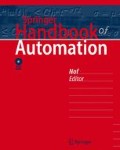Abstract
The world is becoming increasingly linked, integrated, and complex. Globalization, which arrives in waves of increasing and decreasing usage, results in a permanently dynamic environment. Global supply networks, logistics processes, and production facilities try to follow these trends and – if possible – anticipate the volatile demand of the market. This challenging world can no longer be mastered with static, monolithic, and inert information technology (IT) solutions; instead it needs autonomic, adaptive, and agile systems – living systems. To achieve that, new systems not only need faster processors, more communication bandwidth, and modern software tools – more than ever they have to be built following a new design paradigm. As determined by the industrial and business environment, systems have to mirror and implement the real-world distribution of data and responsibility, the market (money)-driven decision basis for all stakeholders in the (real or virtual) market, and the goal orientation of people, which leads to on-demand, loosely coupled, communication with relevant partners (other players, roles) based on reactive or proactive activities.
This chapter provides an insight into the core challenges of todayʼs dynamics and complexity, briefly describes the ideas and goals of the new concept of software agents, and then presents and discusses industry-proven solutions in real-time environments based on this distributed solution design.
Access this chapter
Tax calculation will be finalised at checkout
Purchases are for personal use only
Abbreviations
- 3G:
-
third-generation
- AOI:
-
automated optical inspection
- BDI:
-
belief–desire–intention
- CAN:
-
control area network
- CANbus:
-
controller area network bus
- DSRC:
-
dedicated short-range communication
- EDGE:
-
enhanced data rates for GSM evolution
- ERP:
-
enterprise resource planning
- ETA:
-
estimated time of arrival
- FM:
-
Fiduccia–Mattheyses
- FM:
-
frequency-modulation
- GPRS:
-
general packet radio service
- GPS:
-
global positioning system
- GSM:
-
global system for mobile communication
- IT:
-
information technology
- JSR-001:
-
Java specification request
- LAN:
-
local-area network
- LIFO:
-
last-in first-out
- LORANC:
-
long-range navigational system
- LS:
-
language subsystem
- M2M:
-
machine-to-machine
- OBU:
-
onboard unit
- OR:
-
operating room
- OR:
-
operation research
- PC:
-
personal computer
- PCB:
-
printed circuit board
- RFID:
-
radiofrequency identification
- RTSJ:
-
real-time specification for Java
- SMS:
-
short message service
- TMS:
-
transportation management system
- UMTS:
-
universal mobile telecommunications system
- WAAS:
-
wide-area augmentation system
- WCDMA:
-
wideband code division multiple access
- mPDPTW:
-
multiple pick up and delivery problem with time windows
References
Wikipedia: Automation, http://en.wikipedia.org/wiki/Automation (last accessed February 2009)
P. Davidsson, S. Johansson, J. Persson, F. Wernstedt: Agent-based approaches and classical optimization techniques for dynamic distributed resource allocation: a preliminary study, AAMASʼ03 workshop on Representations and Approaches for Time-Critical Decentralized Resource/Role/Task Allocation (2003)
J.O. Kephart, D.M. Chess: The vision of autonomic computing, IEEE Comput. Mag. 36(1), 41–50 (2003)
S. Bussmann, K. Schild: Self-organizing manufacturing control: an industrial application of agent technology, Proc. 4th Int. Conf. Multi-Agent Syst. (2000) pp. 87–94
D. Greenwood, C. Dannegger: An industry-proven multi-agent systems approach to real-time plan optimization, 5th Workshop Logist. Supply Chain Manag. (2007)
R. Zimmermann: Agent-based supply network event management. Whitestein Series in Software Agent Technologies and Autonomic Computing. (Birkhäuser, Basel 2006)
G. Rimassa, D. Greenwood, M.E. Kernland: The living systems technology suite: an autonomous middleware for autonomic computing, Int. Conf. Auton. Auton. Syst. ICAS (2006)
S. Kim, M.E. Lewis, C.C. White: Optimal vehicle routing with real-time traffic information, IEEE Trans. Intell. Transp. Syst. 6(2), 178–188 (2005)
M.W.P. Savelsbergh, M. Sol: The general pickup and delivery problem, Transp. Sci. 29(1), 17–29 (1995)
K. Dorer, M. Calisti: An adaptive solution to dynamic transport optimization, Proc. 4th Int. Jt. Conf. Auton. Agents Multiagent Syst. (ACM, New York 2005) pp. 45–51
S. Mitrovic-Minic: Pickup and delivery problem with time windows: A survey. Technical Report TR 1998–12 (Simon Fraser University, Burnaby 1998)
W.P. Nanry, J.W. Barnes: Solving the pickup and delivery problem with time windows using reactive tabu search, Transp. Res. B 34, 107–121 (2000)
M. Pěchouček, S. Thompson, J. Baxter, G. Horn, K. Kok, C. Warmer, R. Kamphuis, V. Marík, P. Vrba, K. Hall, F. Maturana, K. Dorer, M. Calisti: Agents in industry: the best from the AAMAS 2005 industry track, IEEE Intell. Syst. 21(2), 86–95 (2006)
General Datacom: Transportation and Wireless Connections, http://www.gdc.com/inotes/pdf/transportation.pdf (Naugatuck 2004)
G. Lawton: Machine-to-machine technology gears up for growth, IEEE Computer 37(9), 12–15 (2004)
D. Greenwood, M. Calisti: The living systems connection agent: seamless mobility at work, Proc. Communication in Distributed Systems (KiVS) (Berne 2007) pp. 13–14
A. Gühnemann, R. Schäfer, K. Thiessenhusen, P. Wagner: New approaches to traffic monitoring and management by floating car data, Proc. 10th World Conf. Transp. Res. (Istanbul 2004)
The European Commission: European Transport Policy for 2010: Time to Decide, (2001) http://ec.europa.eu/transport/white_paper/documents/index_en.htm
M. Wooldridge, N.R. Jennings, D. Kinny: The Gaia methodology for agent-oriented analysis and design, J. Auton. Agents Multi-Agent Syst. 3(3), 285–312 (2000)
F. Zambonelli, N.R. Jennings, M. Wooldridge: Developing Multiagent Systems: The Gaia Methodology, ACM Trans. Softw. Eng. Methodol. 12(3), 317–370 (2003)
C. van Aart: Organizational Principles for Multi-Agent Architectures. Whitestein Series in Software Agent Technologies and Autonomic Computing (Birkhäuser, Basel 2005)
R. Unland, M. Klusch, M. Calisti (Eds.): Software Agent-Based Applications, Platforms and Development Kits. Whitestein Series in Software Agent Technologies and Autonomic Computing (Birkhäuser, Basel 2005)
R. Červenka, I. Trenčanský, M. Calisti, D. Greenwood: AML: Agent Modeling Language Toward Industry-Grade Agent-Based Modeling, Lecture Notes in Computer Science (Springer, Berlin, Heidelberg 2005)
Author information
Authors and Affiliations
Corresponding author
Editor information
Editors and Affiliations
Rights and permissions
Copyright information
© 2009 Springer-Verlag Berlin Heidelberg
About this chapter
Cite this chapter
Dannegger, C. (2009). Real-Time Autonomic Automation. In: Nof, S. (eds) Springer Handbook of Automation. Springer Handbooks. Springer, Berlin, Heidelberg. https://doi.org/10.1007/978-3-540-78831-7_23
Download citation
DOI: https://doi.org/10.1007/978-3-540-78831-7_23
Publisher Name: Springer, Berlin, Heidelberg
Print ISBN: 978-3-540-78830-0
Online ISBN: 978-3-540-78831-7
eBook Packages: EngineeringEngineering (R0)

